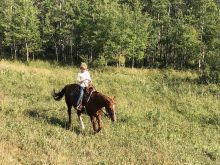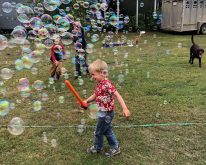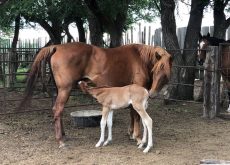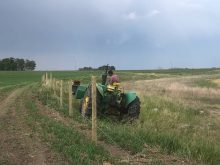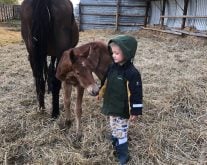There is no rest for the wicked this summer. The old hayfield that we converted into a pasture this spring had been running short of water and so we were trying to figure out how to best manage our pastures and the low water situation.
We were desperately wanting to take some bales off of the other pasture which has water, so were reluctant to move the cows in there. Instead, Gregory and John went water-dowsing again and Gregory found a spot with lots of potential.
So we called Wellen Boring from Saskatoon and they agreed to come out and dig some test holes for us. Since they were coming out anyway, Gregory decided to try to find some better water for the corrals at home. The well that we’ve been using for the corrals has sand coming into it due to the rusted-out casing. The sand makes the floats in the water bowls stick open, which makes a sloppy mess in the summer and a dangerous skating rink in the winter. It’s also high in iron sulphite and so we were going to try out a new stream.
Read Also

Gentle treatments for pain in the neck
Heading toward year-end, people unknowingly tense up against the cold and busyness, causing neck pain that can often be treated with appropriate support and gentle mobility, athletic therapist Kathlyn Hossack says.
The bonus if we can drill a well at the home place is that the water will have to be trenched past our house to get to the corrals, which means the power source and pressure tank will be in our basement. Hopefully, the water can be used for our house as well. We have been filling a water tank from John and Barb’s house for the last six years and it would be a real treat to have our own water.
Successful mission
They found water both at the pasture and at home. The pasture water is extraordinary. It comes in at about 40 gallons per minute and is very low in dissolved solids. The water at home is around nine gallons per minute and is lower in dissolved solids than the old livestock well.
When they came out to develop the wells, my very good friends from the States were here to take part. Michelle and Lacey are like my sisters and we haven’t seen each other for three years. Lacey is James’s godmother, and this visit is the first chance they had to meet. They arrived July 4 and were able to stay five days. We had a good time visiting and they were quite tired every night after playing with Joseph, James and little Ian.

Wellen Boring came out July 7 to develop the well across the road from our house. The next day they worked to develop the well at the pasture. We had a barbeque and fed the crew and then watched as the crew worked.
On July 14 we had the hard task of saying goodbye to a family friend as we attended the funeral of Chris Birn. May he rest in peace.
A couple of days later the family got together early to celebrate John and Barb’s 50th anniversary. We took some family pictures with five of the six children and all of the grandchildren, a total of 14 at this time. Afterward, we attended mass and then had a potluck supper followed by prizes and games.
It was nice to party for the weekend, but afterward, it was back to work. We developed the watering system for the old hayfield by putting a tire trough in place, cementing the centre and setting up a grain bin over the well to be used as a well house. Gregory came up with the idea of using the grain bin. It keeps the animals out of the well, the roof provides a place for the solar panels to be secured where nothing will knock them over, and the control box and all of the wires can be neatly secured to the inside wall.
The cows greatly enjoyed their new fresh water. While we were waiting to get the well set up, we did have to temporarily let the cows onto the native pasture with the replacement heifers. We had developed a well on that pasture last year. Once the old hayfield well and watering system were operational, we were able to move the main herd back over. They will be able to stay on the old hayfield pasture until we can get the bales off the other pasture. They didn’t spend enough days on the native spring heifer pasture to cause any damage.
After the work with the well, we jumped right into haying. On July 26 Gregory and John cut our sainfoin field, part of the clover field and the buffer zones on the organic crops. From there they moved to the ditches. We were watching the weather a bit and decided to try to get what we had cut and baled before cutting much more. Gregory was able to get the sainfoin and the clover baled before we got hit with a severe storm.
Early on the morning of August 2 a horrible wind and thunderstorm came through. We had tornado warnings earlier so both Gregory and I were watching the storm carefully and ready to grab the sleeping boys and run to the root cellar if needed. Finally, the storm settled down. Later we found trees blown down, the gardens mangled, and lots of shingles missing from our roof. There was over an inch of rain in the rain gauge. We are very thankful that it wasn’t any worse.





